Musical Miscastings – Wherein Frank Sinatra And Ella Fitzgerald Try Trading Styles
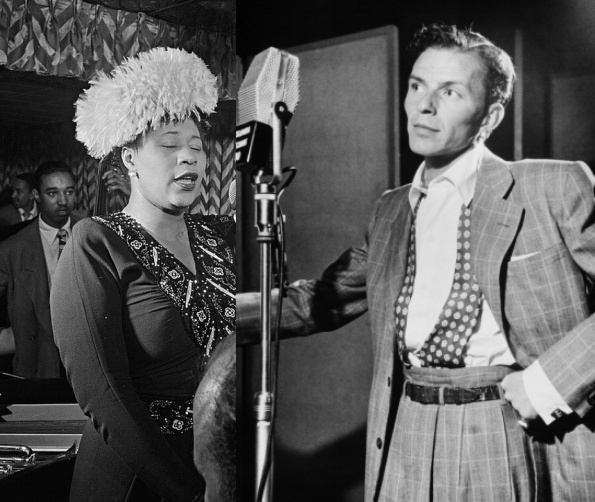
Once a month or so I have brought old jazz records out of the digital closet. I present them because I have found them worthwhile, and try to describe what I find worthwhile in them.
But today we change things up with a couple of examples that show that even the greatest musical talents have occasionally been mis-applied in poor matches of performers or material. When that can happen with such greats as Ella Fitzgerald and Frank Sinatra, it can happen to anyone.
Everybody is familiar with the concept of “miscasting”. No, not getting your fishing lure caught in the branches of the tree behind you, but the “art” of putting an actor in a role that is all wrong (or is it the role that is correct and the actor who is all wrong?) Either way, we all know it. Whether it might be John Wayne cast as Genghis Khan in “The Conqueror” from 1956 or Johnny Depp as Tonto in 2013’s “The Lone Ranger, these are memorable examples of actors who are really good at what they do showing how they can be less good at what they don’t do.
Mention the name “Ella Fitzgerald” and the first thing that pops into most minds will be “jazz singer extraordinaire”. Mention the name “Frank Sinatra” (especially if we are talking pre-1954) and the word “crooner” elbows its way to the front. Sooooo, what happens when you ask Ella to croon and Blue Eyes to do jazz? You get records like these.

Ella Fitzgerald with Dizzy Gillespie, 1947
Let’s go with Ella first. We recently featured a fabulous record from 1946 where she sung a smoky, bluesy little number that makes you feel you are sitting next to the piano with a glass of scotch in one hand and a smoldering cigarette in the other. It is a place you do not want to leave.
As we discussed there, Ella was feeling her way from fronting a band into a solo act. Under the direction of Decca music producer Milt Gabler, Ella tried a number of different musical directions before she made the connection with Norman Granz (and his Clef Records label) who gave her the kind of artistic freedom that someone like Ella needed to flourish in an era when suits seeking hit records controlled as much of the “music business” as they do today.
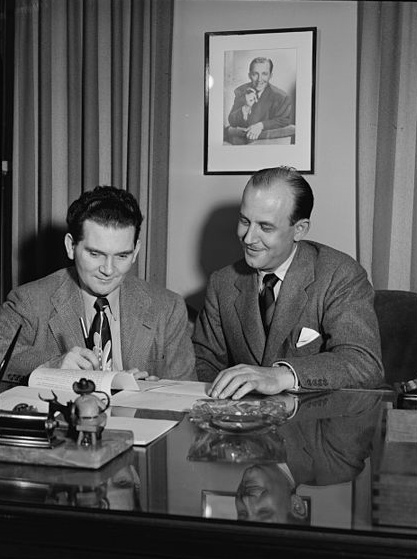
Milt Gabler (r)
Now let’s just get this out there: Undistinguished crooners with backup singers started to rule the jukeboxes as the 1940’s came to an end, a trend that would continue into the early 50’s. It is not hard to understand how rock & roll burst forth because the “jazz as popular music thing” was on life support. As an aside, Milt Gabler was the one who signed Bill Haley & His Comets to Decca a few years later. Oh, and he was also Billy Crystal’s uncle.

Frankie Laine (r), very likely accepting a gold record award for his Mercury Records’ recording of That’s My Desire in 1947.
This disc, recorded March 19, 1947, is not a bad record, of course. Ella could sing anything, and she turns in a good, serviceable performance here on a song that would have several versions on the pop charts that year. It was an odd case – a song that went back to 1931 but that suddenly grabbed everyone’s attention for the first time in 1947. Young singer Frankie Laine had the most success with it, with his record selling over a million copies. Though I never understood why.
Anyway, we are rewarded in the final 1/3 of the piece when some of the real Ella starts to come through this otherwise bland and forgettable arrangement that was clearly not written with her in mind at all. And who was the Andy Love Quintet? Or band leader Bob Haggart? I haven’t the slightest idea.

So what about Sinatra? Frank Sinatra got his start as a band singer just like Ella did, only a few years later. Sinatra had the most beautiful voice, and in the first one-third of his career was never better than when that soft, silky voice was making love to a microphone during a lush ballad. If you listen to some of his early stuff, you will see why one of his first nicknames was The Voice.
Now Frank could sing the up-tempo stuff too, but he was no jazz singer. Even in his later years when his style loosened up a lot, Ol’ Blue Eyes never strayed far from the melody and what little improvising he did was as occasional punctuation rather than something built into the way he approached a song. With rare exceptions, it was the musicians who followed and accommodated Sinatra, not the other way around.
Which showed when he was mated with the Metronome All-Stars in December of 1946. Metronome Magazine was a popular jazz periodical of the day and conducted more-or-less annual polls where readers voted on top musicians for various instruments. The winners would be brought together for a couple of recordings which usually allowed each a bit of solo time – sort of like an All-Star game for musicians.
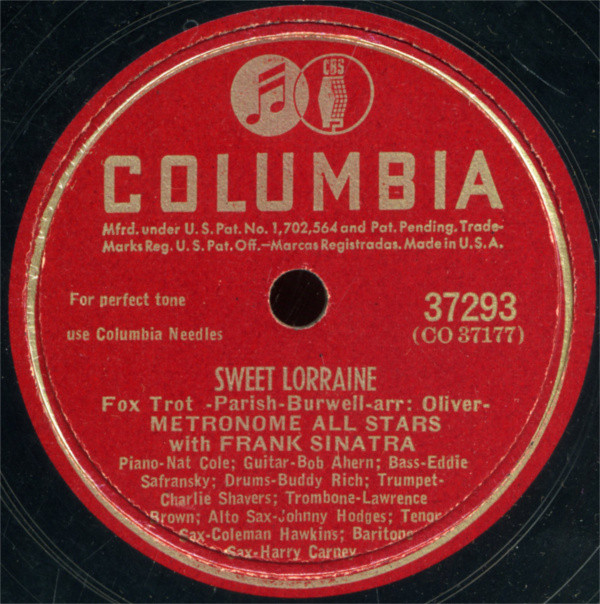
The group on this record was, well, stellar. Many of the names are well known to even casual fans of this kind of music today, and we have featured several of them here, such as Nat King Cole (piano) and Coleman Hawkins (tenor sax).
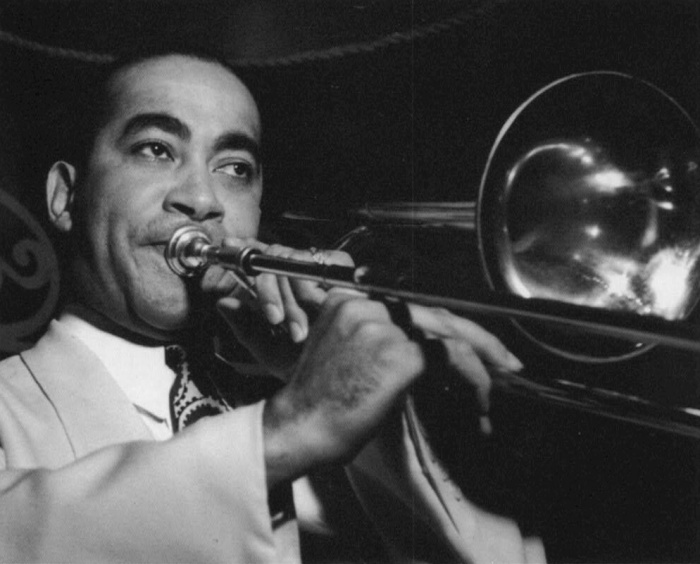
Lawrence Brown
We have indirectly brought you Johnny Hodges (alto sax), Lawrence Brown (trombone) and Harry Carney (baritone sax) playing with Duke Ellington and Eddie Safransky (bass) who spent several years with Stan Kenton. These and the other poll-winners came together with Sinatra as he was (unknowingly) approaching the end of his early success.

Nat King Cole
Nat Cole’s sparkling piano starts it off, taking turns with Eddie Safransky’s bass and Buddy Rich’s drums as they pave the playground for the others to do their thing.
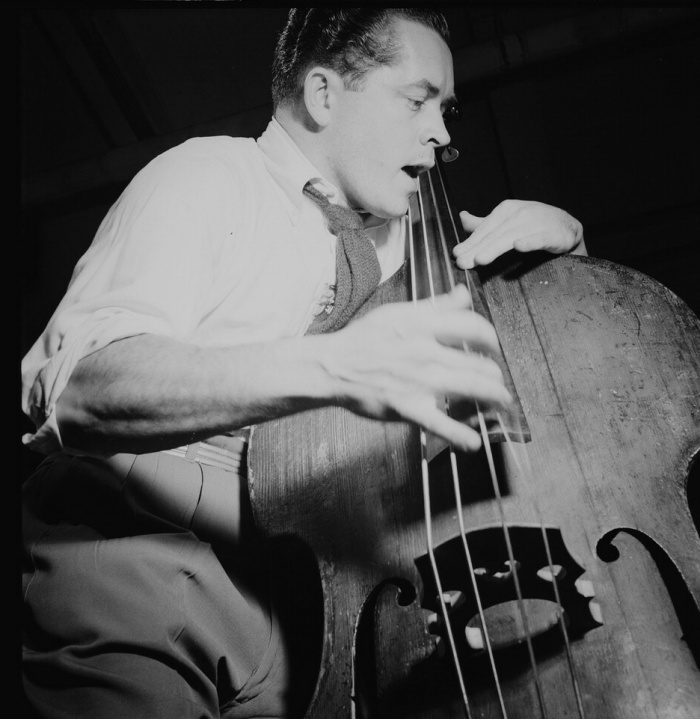
Eddie Safransky
The instrumentals are a delight, such as the way Safransky’s bass just bubbles behind Charlie Shavers’ trumpet solo.
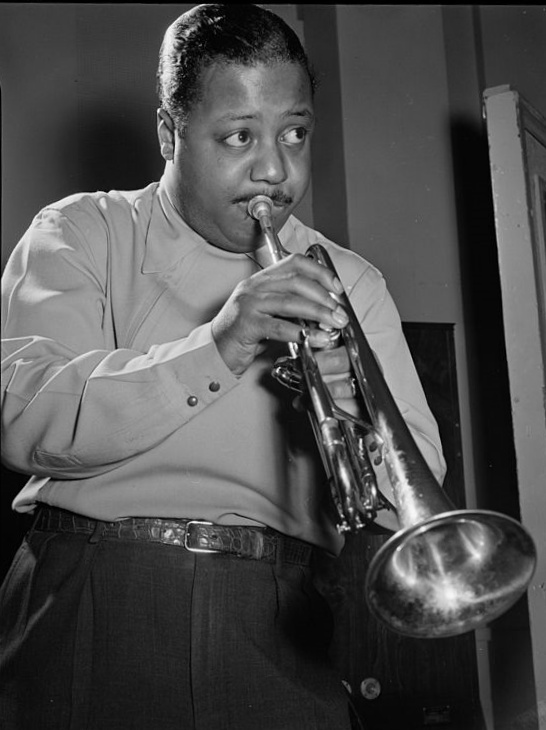
Charlie Shavers
But . . . try as he might, Sinatra seemed a bit wooden compared with those around him. The musicians were not suited for (at least in this kind of a project) a typical well-polished Sinatra arrangement and he seems tight, struggling to join the relaxed improvisational flow.

Coleman Hawkins
Perhaps the Frank Sinatra of fifteen or twenty years later would would have fit in with this group. But sadly, the pairing of this group of all-star jazzmen and this all-star singer just didn’t gel. That there were no more projects like this suggest that everyone in the room knew it.
Noted Sinatra expert Charles Granata has described the record as a highlight of Sinatra’s years of recording for Columbia (1943-52). I would add a big asterisk – it may be a highlight, but not so much because of Frank’s performance.
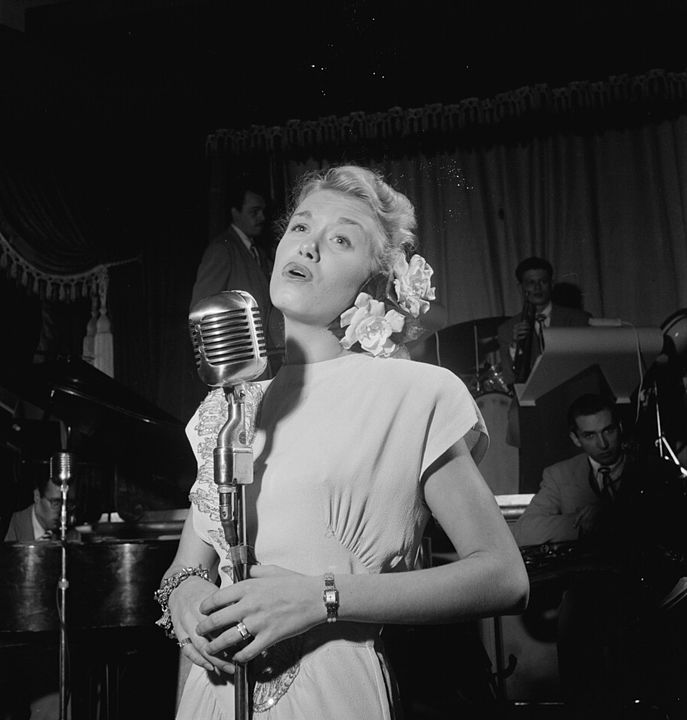
June Christie
For contrast, just listen to the other record made in that session (because you know you don’t have anywhere to go), where Nat Cole and June Christie (whom we have also featured) handled the vocal duties for a blues in which there are no weak links.
It was ever true that not everyone is good at everything. Though far from unlistenable, each record shows jazz artists straining against pop talent (and vise versa). It would have been interesting had Frank and Ella swapped places in these two recording sessions – perhaps a pair of really great records would have resulted. Instead, we got curiosities that show two peerless vocalists who were still young and not yet in charge of their own fates when they were steered into styles that suited them poorly.
The December 1946 Metronome All-Stars Personnel: Nat King Cole (piano, vocal), Buddy Rich (drums), Eddie Safranski (bass), Bob Ahern (guitar); Charlie Shavers (trumpet), Lawrence Brown (trombone); Johnnie Hodges (alto sax), Coleman Hawkins (tenor sax), Harry Carney (baritone sax), Frank Sinatra (male vocal), June Christy (female vocal).
Music Credits
Ella Fitzgerald’s March 19, 1947 Decca recording of That’s My Desire from the YouTube page of the78prof
The December 17, 1946 recording of Frank Sinatra and the Metronome All-Stars, released by Columbia Records, as found on the Frank Sinatra youTube page
Photo Credits
Opening photo – Ella Fitzgerald – c. September, 1947 and Frank Sinatra c. 1947 photographs by William P. Gottlieb, in the public domain, cropped and combined, and in their full forms as credited below.
Ella Fitzgerald – c. September, 1947 photograph by William P. Gottlieb, in the public domain.
Milt Gabler (right) signing accordionist Joe Mooney (left) to Decca – c. December, 1946 photograph by William P. Gottlieb, in the public domain.
Frankie Laine – c. 1946-48 photograph by William P. Gottlieb, in the public domain.
Frank Sinatra – c. 1947 photograph by William P. Gottlieb, in the public domain
Columbia Records label for the original issue of Sweet Lorraine as found on Discogs.com
Lawrence Brown – c. November, 1946 photograph by William P. Gottlieb, in the public domain
Nat King Cole – c. June 1947 photograph by William P. Gottlieb, in the public domain
Eddie Safranski – c. January, 1947 photograph by William P. Gottlieb, in the public domain.
Charlie Shavers – c. May, 1947 photograph by William P. Gottlieb, in the public domain
Coleman Hawkins at New York’s Spotlite Club – c. September, 1946 photograph by William P. Gottlieb, in the public domain
June Christy – c. September, 1947 photograph by William P. Gottlieb, in the public domain

Some great observations about artists getting out of their comfort zones. My mind initially went to somebody doing a cover of a song associated with someone else (such as William Shatner singing C. Lo Green’s “Forget You” – well that title is close enough – that is so bad it’s good) but that really wasn’t your intent. When talking genres the one that sticks out to me is Tammy Wynette accompanying a English dance group in the early 1990s with “Justified & Ancient”. Unlike Sinatra in your example, Wynette pulls it off.
Your reference to Frankie Laine helps me. I had known he was a singer but only knew him for the western style ballad he did as the theme song for a relatively forgettable show.
LikeLiked by 1 person
Wow, both of those are new to me. I agree with your assessment of each. That would be an interesting collection – really out-there musical combinations, some that work and some that don’t.
That’s My Desire was Frankie Laine’s first big hit, and he went on to a long career. I can’t really say I was ever a fan, though he could belt out a western ballad. He was at the leading edge of a wave that featured a punchy, high-emotion style that made previous singers obsolete – as happened to Sinatra before he reinvented himself in the mid 50s.
LikeLike
That’s such bland and smarmy backing vocals behind Ella and Sinatra just sounds bored to me.
Speaking of Frankie Laine, he sang the theme for Mel Brooks’ Blazing Saddles. The story is that he sang his heart out on it because they hadn’t told him it was a spoof.
Blazing Saddles was the last movie was saw with my dad at the “Grandpa Film Festival” before corona virus put a stop to that.
LikeLike
At the time, Sinatra was the king of the smooth ballad. I never much liked his up-tempo stuff too much because it seemed outside of his sweet spot. As he aged his style improved as his voice aged. What he lost in pure vocal ability he made up for in style.
There are a lot of people who like Frankie Laine, but everything he ever did sounded the same to me. And I have not seen Blazing Saddles in a long time.
LikeLike
That was interesting JP. Thank you for I’m adding to my fledgling education in jazz. How young they all look. It amazes me all the names they were able to fit on those record labels…
LikeLike
Thanks, Joni. I am not sure when I stopped looking at old black and white pictures of that era and seeing old people to looking at them and seeing really young people, but it definitely happened. And it was not often that you got so many names on the record labels.
LikeLiked by 2 people
When I started reading this post, I was thinking: JP has such a sharper ear than I and so much more expertise (actually, I have none) that there’s no way I’ll detect the subpar performances of two of my all-time favorites.
But I did feel that Sinatra was straining in places. Ella was fine to my less sophisticated ear.
Still a delightful listening experience via your tutelage.
LikeLiked by 1 person
I always enjoy feedback from people listening to something for the first time and not steeped in this style.
LikeLike
Pingback: Tea For Two – Some Classic Takes On A Perennial Jazz Favorite | J. P.'s Blog